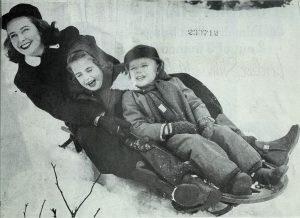 We love to hear our elders reminisce about holidays. Their memories help tie families together and strengthen bonds. These gatherings sometimes bring challenges but they sure do stick in our hearts and minds. The topic of holidays is great material for story gathering, especially for the younger generations who’d love to know what your childhood was like. So much changes over the decades, world events, technology, customs — open up the door for a sneak peek into this part of your story. Make sure you add in some of these details as you go through the following questions. You’ll all be glad you did.
We love to hear our elders reminisce about holidays. Their memories help tie families together and strengthen bonds. These gatherings sometimes bring challenges but they sure do stick in our hearts and minds. The topic of holidays is great material for story gathering, especially for the younger generations who’d love to know what your childhood was like. So much changes over the decades, world events, technology, customs — open up the door for a sneak peek into this part of your story. Make sure you add in some of these details as you go through the following questions. You’ll all be glad you did.
The book Recording Your Family History provides some great prompts for recording your childhood holiday memories:
“Think back and describe who would be there
around the table and what it was like for you on that holiday.”
Here’s a few questions to start with:
Can you describe in detail one particularly memorable year?
What type of food would you eat?
What was your favorite tradition?
What was it like?
Were there special religious festivities as part of your holiday celebration?
Did you ever receive or give a gift with especially great meaning?
How about now, what do your holidays look like?
Do you still make special recipes handed down in your family?
What holidays have you celebrated that carried forward from your ancestors? Tamales? Lutefisk? Baklava?
I’d love to hear about your holiday memories, drop me a line.
Karen
 Celebrate Agriculture! Whatever language you say it in, shout it loud this fall. I’ve been crazy busy this week getting ready to celebrate the 100th Anniversary of an irrigation district in southern New Mexico. It’s fun to be part of telling the story. I’ve been immersed in great photos old and new of hardworking people building, farming, irrigating and otherwise engaged in the age old struggle to produce food, clothing and shelter. It’s humbling and awe inspiring.
Celebrate Agriculture! Whatever language you say it in, shout it loud this fall. I’ve been crazy busy this week getting ready to celebrate the 100th Anniversary of an irrigation district in southern New Mexico. It’s fun to be part of telling the story. I’ve been immersed in great photos old and new of hardworking people building, farming, irrigating and otherwise engaged in the age old struggle to produce food, clothing and shelter. It’s humbling and awe inspiring. We need to be reminded of the power of ordinary conversations and their ability to encourage. This morning I interviewed a colleague at a local business where I do some public information writing. She is professional, friendly and extremely competent. Before today we had only visited on a surface level for a few minutes at a time. But today was different. We sat and just talked. Yes, I was interviewing her for the company newsletter, but I was also just listening to her story. She spoke about resilience, about choosing joy in difficult circumstances, about loving your children and valuing your work and friendships.
We need to be reminded of the power of ordinary conversations and their ability to encourage. This morning I interviewed a colleague at a local business where I do some public information writing. She is professional, friendly and extremely competent. Before today we had only visited on a surface level for a few minutes at a time. But today was different. We sat and just talked. Yes, I was interviewing her for the company newsletter, but I was also just listening to her story. She spoke about resilience, about choosing joy in difficult circumstances, about loving your children and valuing your work and friendships. Helping someone share their story changes lives. The process of speaking and hearing memories and experiences will transform you both. We have a craving to be heard. This is one of the best gifts I can give people I work with. Yes, it is wonderful to hold your book in your hands and share this tangible expression with those you care about. But the entire process of creating it is validating and honoring.
Helping someone share their story changes lives. The process of speaking and hearing memories and experiences will transform you both. We have a craving to be heard. This is one of the best gifts I can give people I work with. Yes, it is wonderful to hold your book in your hands and share this tangible expression with those you care about. But the entire process of creating it is validating and honoring. Anam Cara
Anam Cara